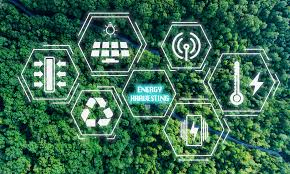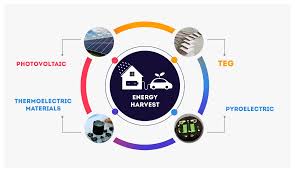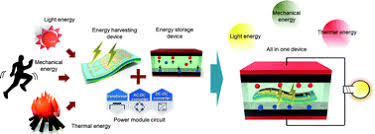
Introduction
Energy-harvesting materials are technologies that capture and convert ambient energy from the environment—such as heat, motion, light, or vibrations—into usable electrical power. These materials hold the potential to revolutionize energy systems by offering sustainable, low-cost solutions to power small devices and sensors without relying on traditional batteries or external power sources. With the increasing need for sustainable and efficient energy sources, energy-harvesting materials could become integral to the future of electronics, wearable technologies, and the Internet of Things (IoT).
How It Works
Energy-harvesting materials work by capturing small amounts of ambient energy and converting it into electricity. There are several types of energy-harvesting mechanisms, including:

- Piezoelectricity:
Certain materials generate an electrical charge when subjected to mechanical stress or vibration. This effect is commonly used in harvesting energy from motion, such as footstep-based energy generation or vibration-based power harvesting in machines. - Thermoelectricity:
Thermoelectric materials generate electricity when subjected to a temperature gradient. These materials can capture heat differences (such as the heat from the human body, machinery, or solar radiation) and convert them into electrical energy. - Photovoltaic:
Photovoltaic materials, or solar cells, convert light into electricity. While solar power is well-known, advancements in flexible and transparent solar materials could open new applications for energy harvesting from ambient light in various environments. - Electromagnetic Induction:
This process generates electricity through the movement of a conductor within a magnetic field. It’s commonly used in devices like small-scale energy harvesters that collect energy from moving machinery or environmental vibrations. - Triboelectricity:
This involves generating electricity through the friction between two materials, which leads to the transfer of charge. It’s used in some wearable devices and technologies that harvest energy from body motion.
Potential Benefits

- Sustainability:
Energy-harvesting materials offer a cleaner alternative to traditional energy sources. By capturing energy from ambient sources such as heat or movement, they help reduce reliance on nonrenewable resources and fossil fuels, making them highly sustainable. - Cost-Effectiveness:
Once deployed, energy harvesters have low operational costs since they do not require ongoing fuel inputs like conventional energy sources. For applications like remote sensors or wearable devices, energy harvesting can significantly reduce or eliminate the need for batteries. - Reduced Environmental Impact:
As energy-harvesting technologies do not rely on the extraction of raw materials for fuel, they generate less environmental impact than conventional power sources, such as coal or oil. This makes them a great solution for environmentally conscious applications. - Self-Sufficiency:
Energy-harvesting materials can enable devices and systems to be self-sustaining, particularly in remote or off-grid areas. This technology can be used to power sensors, medical devices, or environmental monitoring systems that otherwise would need external power sources or batteries. - Integration into Wearable Technologies:
Wearable devices, such as fitness trackers or smartwatches, can benefit from energy-harvesting materials that generate power from body movement, reducing the need for battery charging and extending the lifespan of the device.
Why It’s Underrated
Energy-harvesting materials, despite their immense potential, are often overshadowed by more widely discussed technologies such as solar power or wind energy. Several reasons contribute to this:
- Limited Efficiency:
Energy-harvesting materials often produce small amounts of power, which limits their use to low-energy applications or supplemental power sources rather than primary energy generation. However, with advancements in materials science, this could change in the future. - Public Awareness:
While the potential of energy harvesting is promising, many people are unaware of its applications and benefits. The technology still hasn’t reached the level of mainstream adoption that would make it a household term. - Complexity and Scalability:
Some forms of energy harvesting, such as piezoelectric and thermoelectric materials, are difficult to scale up efficiently for widespread use. Continued research and development are needed to overcome these hurdles.
Challenges Ahead

- Low Power Output:
One of the primary limitations of energy-harvesting materials is the relatively low power output they produce. For larger devices, capturing enough energy to be practically useful can be challenging. However, innovations in materials, design, and energy storage could help overcome this limitation. - Cost of Materials:
Some energy-harvesting technologies rely on advanced or rare materials that are expensive to produce. Research into cheaper, more abundant materials could help lower costs and make these technologies more accessible. - Integration with Existing Systems:
Incorporating energy-harvesting materials into existing devices and infrastructure may require redesigning systems or creating new methods for energy storage. This could be a significant challenge in industries that rely on established power sources. - Efficiency Gains:
To make energy harvesting more viable for a broader range of applications, researchers must focus on increasing the efficiency of energy conversion and improving the storage of harvested energy. New materials and technological advances are essential for achieving this.
Conclusion
Energy-harvesting materials represent a key innovation in the quest for sustainable and efficient energy solutions. By converting ambient energy sources like motion, heat, and light into usable electrical power, they offer numerous benefits, including reducing reliance on traditional energy sources and lowering environmental impact. While the technology faces challenges such as low efficiency and scalability, ongoing research is likely to overcome these obstacles, unlocking broader applications for energy harvesting in fields ranging from wearables to smart cities. As the technology advances, energy-harvesting materials could play a pivotal role in creating a more sustainable and self-sufficient energy future.

